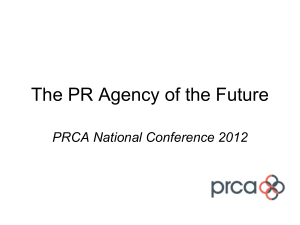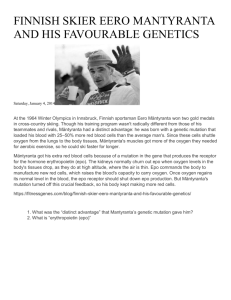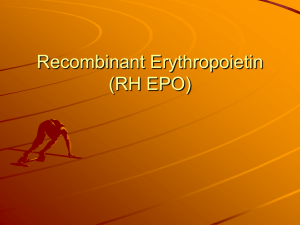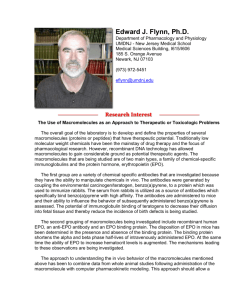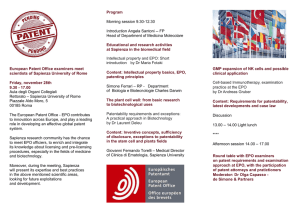Epoetin-induced antibody-mediated pure red cell aplasia and
advertisement
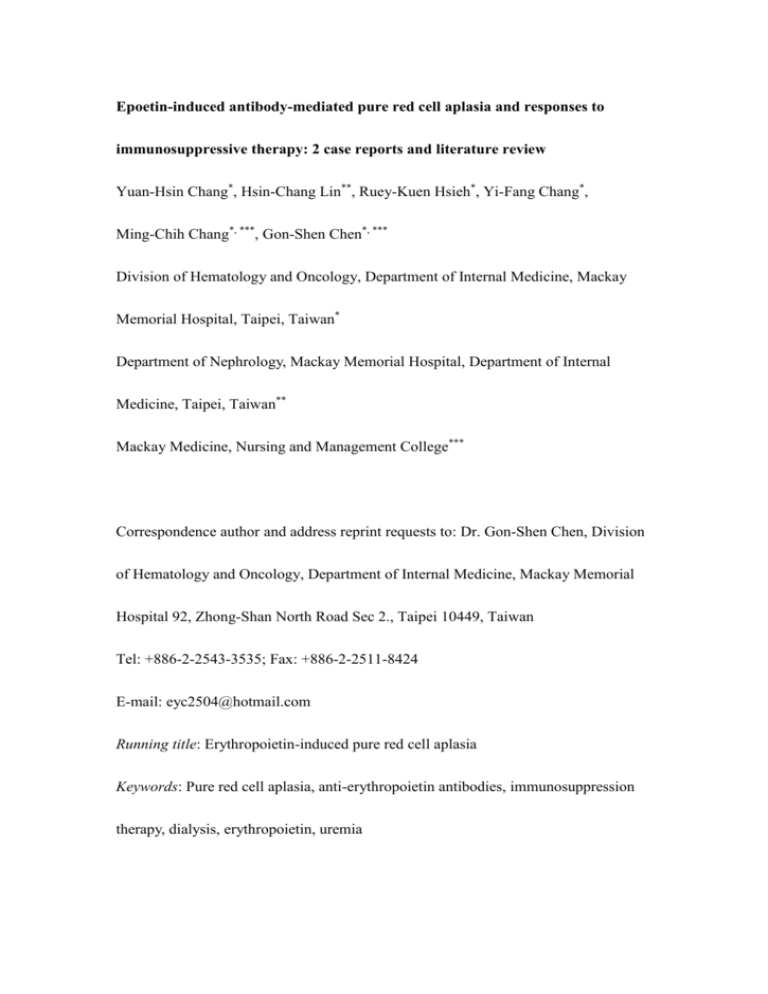
Epoetin-induced antibody-mediated pure red cell aplasia and responses to immunosuppressive therapy: 2 case reports and literature review Yuan-Hsin Chang*, Hsin-Chang Lin**, Ruey-Kuen Hsieh*, Yi-Fang Chang*, Ming-Chih Chang*, ***, Gon-Shen Chen*, *** Division of Hematology and Oncology, Department of Internal Medicine, Mackay Memorial Hospital, Taipei, Taiwan* Department of Nephrology, Mackay Memorial Hospital, Department of Internal Medicine, Taipei, Taiwan** Mackay Medicine, Nursing and Management College*** Correspondence author and address reprint requests to: Dr. Gon-Shen Chen, Division of Hematology and Oncology, Department of Internal Medicine, Mackay Memorial Hospital 92, Zhong-Shan North Road Sec 2., Taipei 10449, Taiwan Tel: +886-2-2543-3535; Fax: +886-2-2511-8424 E-mail: eyc2504@hotmail.com Running title: Erythropoietin-induced pure red cell aplasia Keywords: Pure red cell aplasia, anti-erythropoietin antibodies, immunosuppression therapy, dialysis, erythropoietin, uremia Abstract Recombinant human erythropoietin (rHuEPO) induced pure red cell aplasia (PRCA) was a rare disease. Herein, we reported the only 2 cases with confirmed diagnosis of EPO- induced PRCA in Mackay Memorial Hospital. Case 1: a 53 year-old female with uremia and regular hemodialysis was regularly administered with EPO-α (Eprex) subcutaneously (s.c.). Progressive unexplained anemia was noted 13 months after therapy with Eprex. Bone marrow study revealed remarkable erythroid hypoplasia compatible with PRCA. Anti-EPO antibody levels were detected. After withdrawal of Eprex and administration of cyclosporine, her anemia gradually improved. Serum level of anti-EPO antibody became undetectable. Another form of EPO (darbepoetin) was administered to the patient and hemoglobin recovered to 10.4 g/dL. Case 2: a 46 year-old male patient with chronic kidney disease related anemia underwent a regular subcutaneous EPO-β (Recormon) therapy. He developed profound anemia in spite of dose increase of EPO-β and combination with darbepoetin usage. Consequently anti-EPO antibody was detected. Cessation of EPO and initiation of immunosuppression therapy with methylprednisolone and azathioprine was instituted. The patient finally became transfusion-independent. Introduction Recombinant erythropoietin (EPO) is used successfully to treat anemia in chronic kidney disease (CKD), to maintain stable hemoglobin levels, and to avoid the need for multiple transfusions. Recently, antibody-mediated PRCA has been associated with the administration of EPO and identified as a serious complication. The incidence of epoetin-associated PRCA increased considerably in 1998, reached a peak in 2002, and decreased sharply since 2003.1 EPO discontinuation and administration of immunosuppressive treatment can accelerate recovery from PRCA induced by EPO.2 Here we report 2 cases of EPO associated PRCA, the successful management of their diseases, and a review of related literature. Case Report Case 1 The 53 year-old female had a history of hypertension and chronic glomerulonephropathy. She developed uremia with regular hemodialysis since December 2002. Eprex 2000u (Johnson & Johnson; uncoated rubber stopper, polysorbate 80 as stabilizer) was administered subcutaneously biweekly for her chronic kidney disease (CKD) associated anemia. She suffered from mild skin itchiness after Eprex injection. Exacerbation of anemia began in January 2004, which was 13 months after initiation of Eprex therapy. Hematological data showed a rapid drop from hematocrit 28.8% to 22.1% in one month. A full examination for blood loss (including stool occult blood, upper and lower gastrointestinal endoscopies) was negative. There was no evidence of hemolysis or hemoglobinopathies or iron, vitamin B12, or folate deficiencies. Her ferritin level was 510ng/ml. Viral serology failed to identify a recognized cause. A low reticulocyte count of 3013/μL was also observed. A radioimmunoprecipitation (RIP) test detected the presence of anti-EPO antibodies (PPD Development CLIA Immunochemistry Laboratory Richmond VA). Bone marrow aspiration smear revealed a marked scarcity of erythroid precursors, and it was compatible with PRCA (Fig.1). Cyclosporine (2~3mg/kg/day initially from June 2004 to May 2005) and prednisolone (25mg/day) was instituted. We discontinued prednisolone due to complaints of epigastragia. Anti-EPO antibody level was rechecked and it became undetectable by 8 months post treatment. To treat her anemia, darbepoetin (Aranesp) 40μg was prescribed weekly since April 2005. A good response was observed at 7 months later and darbepoetin dose was reduced to 25μg/week. The hemoglobin gradually increased to 10.4 g/dL. The patient had recovered from rHuEPO-induced PRCA and successfully switched to another erythopoiesis-stimulating agent (ESA). Case 2 A 46 year-old male patient had CKD and was started on EPO-β (Recormon, Roche) 2000u s.c. biweekly in February 2006 to maintain at hemoglobin at 8~10 g/dL (Fig.2). No skin or systemic allergic reaction was noted in the patient with Recormon. Disease progression to uremia was noticed, and he underwent peritoneal dialysis. However, his Hb gradually dropped to 6~8g/dL in spite of regularly administered Recormon. Recormon dose was increased to 5000u biweekly s.c., but his anemia continued to deteriorate. His Hb declined to 4.0 g/dl and he became transfusion-dependent (PRBC 4units/month). Aranesp was added 25μg once weekly, but in vain. Further workup of his anemia revealed negative occult blood test. Upper and lower gastrointestinal endoscopies also showed negative finding. Ferritin level was 552ng/ml. No evidence showed parvovirus B19 infection. Investigations to ascertain a cause for the anemia were essentially negative. Therefore, he was referred to our hematology clinic. Lab data revealed Hb 5.4 g/dL, Hct 15.2%, MCV 82.8fL, reticulocyte 1190/μL. Bone marrow examination showed a marked decrease in erythroid series, with a < 5% of total nucleated cells which was compatible with PRCA by 8 months post rHuEPO. Serum anti-EPO antibody levels were measured by an enzyme-linked immunosorbent assay (ELISA) kit, MicroCoat Biotechnologie GmbH. The confirmatory assay demonstrated detectable anti-EPO-β antibodies 212ng/ml. We started immunosuppressive therapy with methylprednisolone at 8mg daily and azathioprine at 50mg daily since Aug 2008, and discontinued rHuEPO. His hemoglobin gradually increased to 5.8g/dL, and blood transfusions were not required. Discussion EPO induced PRCA is a rare condition. Patients may develop Abs against the EPO protein. The Abs neutralize all currently available ESA and the patient’s endogenous EPO. The proposed diagnostic criteria published by an ad hoc international working group of expert hematologists and nephrogist (table 1)3 included progressive anemia, low absolute reticulocyte count, severe scarcity of erythroblasts in bone marrow, resistance to ESA therapy, and presence of anti-EPO neutralizing antibody. Progressive anemia was caused by a completed arrest of erythroid results, on average, in a 1% daily reduction in hemoglobin level. The blood reticulocyte count is usually very low (<10,000/μL). The cellularity of bone marrow is typically adequate with normal myeloid cells and megakaryocytes. However the erythroblasts are either complete absence or constitute < 5% of total nucleated cells in the bone marrow. These features distinguish PRCA from aplastic anemia and myelodysplastic syndrome. In the proposal, major features are distinguished from minor features that may provide suggestive evidence for the diagnosis of EPO induced PRCA which should be confirmed by bone marrow study and serum assays for antibodies. EPO antibodies are identified by a variety of assays, including RIP assays, ELISA, and surface plasmon resonance procedures.2 Neutralizing activity of the antibodies was confirmed by an in vitro bioassay .4 Bioassays are relatively time-consuming. Only a minority of cases reported the results. Only 3 cases of EPO-associated PRCA were reported prior to 1998, but almost 200 cases were described in patients who had CKD and were treated with ESA injected s.c. between 1998 and 2004. The possible mechanisms of EPO-PRCA were as follows: First, human serum albumin (HSA) was replaced with polysorbate 80 to avoid Creutzfeldt–Jakob disease (CJD).5 In 1998, the HSA in the formulation of Eprex marketed in Europe was replaced with polysorbate 80 as a stabilizer. Subsequently, a sharp increase in EPO-PRCA occurred. Most cases of PRCA outside the US with epoetin-α have been attributed to polysorbate 80 in place of HSA as a stabilizer for epoetin.6 Second, the route of subcutaneous injection, especially self-administered with storage and handling issues has the potential to augment antibody formation.7 Third, increased incidence of PRCA was associated with leachates from the uncoated rubber stopper used in pre-filled syringes. The leachates increased EPO aggregation which enhanced its antigenicity. In mid-2003, the manufacturer of HSA-free Eprex replaced the rubber stopper of pre-filled syringes with Teflon-coated plungers. Subsequently, the exposure-adjusted incidence rate decreased 13-fold with IV administrated Eprex.6 Silicon oil was a lubricant in the pre-filled syringe of eprex and was another possible cause of increased immunogenicity .6 Fourth, polysorbate 80 and polysorbate 20 (stabilizer of Recormon) may induce the formation of epoetin-containing micelles8 and increase immunogenicity. The polysorbate 80 concentration (0.03%) in eprex is higher than polysorbate 20 concentration (0.01%) in Recormon. The higher risk of Eprex in EPO-induced PRCA than Recormon appears related to higher concentration of micelles and their related immune reactions. Furthermore, darbepoetin in Europe and Canada is formulated with lower polysorbate 80 concentration than the Eprex formulation. (0.005% vs. 0.03%).9 Fifth, processing, such as freeze-drying, and formulations that facilitate the oxidation or aggregation of protein can enhance immunogenicity.6 Heat, sunlight and other stressful environmental conditions may cause denaturation of proteins, which may increase their potential immunogenicity.10 Sixth, the glycosylation of EPO may reduce immunogenicity, and has been called the shielding effect. Carbohydrates on EPO molecules can also increase molecular stability, solubility, and in vivo biological activity.11 While more glycosylation sites may decrease the immune reaction in some cases, the EPO analogue darbepoetin-α carries two additional glycosylation sites that permit a higher degree of glycosylation than Eprex and Recormon.12 National authorities and manufacturers of EPO are collaborating to resolve the induction of EPO-related PRCA. Intravenous (iv) administration appeared less likely than subcutaneous administration to evoke an immune response.13 In 2002, European Union regulatory authorities mandated that CKD patients should be administered with Eprex i.v. instead of s.c. and the annual number of Eprex associated PRCA declined 90%.9 In 2003 and 2004, regulatory authorities in Canada, Singapore, and Australia mandated hemodialysis patients to receive administration of Eprex i.v. and nondialyzed CKD patients to receive darbepoetin s.c. Consequently, only six cases of Eprex-related PRCA have been reported.8 We propose that immediate cessation of particular erythropoiesis-stimulating agents and initiation of immunosuppressive agents are required to treat EPO related PRCA. However, an exception was seen in a patient who suffered from Eprex related PRCA and responded well to darbepoiectin with persistant EPO antibodies without immunosuppressive therapy.14 The most common immunosuppressive agents were steroids, cyclosporine, cyclophosphamide, and rituximab.15 Mycophenolate mofetil, plasma exchange and immunoadsorption16 were occasionally used, but varying effectiveness. Kidney transplantation is an alternative approach on patients with EPO associated PRCA.17 In a retrospective study enrolling 47 patients with EPO related PRCA indicated Eprex (Ortho biotech) administered s.c. was the most common culprit (table 2).18 The median time between start of EPO treatment and occurrence of PRCA was 11 months. Nine patients received no immunosuppressive treatment, and none of these recovered. Of the 37 patients who received immunosuppressive therapy, 29 (78%) recovered. Recovery rates were between 56 and 88 percent in patients treated with steroids, steroids plus cyclophosphamide, or cyclosporine. Six of six patients who received a kidney transplant completely recovered within 1 month. These patients were treated with induction therapy followed by triple immunosuppressive agents. No relapse of PRCA occurred in any patients who recovered, even though immunosuppressive therapy was stopped. Nevertheless, no recovered patients were subsequently treated with EPO. Conclusion The incidence of EPO- induced PRCA has decreased in recent years after collaboration of national authorities and manufacturers. Nevertheless, physicians should be alert to EPO-induced PRCA, if CKD patients experience poor response to EPO, rapid decline of hemoglobin after exposure of ESA, and extremely low reticulocyte counts. Increased EPO dosage and initiation of another EPO should be avoided until the patient is evaluated for anemia and exclusion of EPO induced PRCA. Further investigations including a bone marrow exam and EPO antibodies measurement should be undertaken. Patients who developed EPO-related PRCA may benefit from cessation of EPO and initiation of immunosuppression therapy. Kidney transplantation may cure the disease. Administration with a different ESA could be considered in those patients with undetectable EPO antibodies. REFERENCES 1. Eckardt KU, Casadevall N. Pure red-cell aplasia due to anti-erythropoietin antibodies. Nephrol Dial Transplant2003 May;18(5):865-9. 2. Thorpe R, Swanson SJ. Current methods for detecting antibodies against erythropoietin and other recombinant proteins. Clin Diagn Lab Immunol2005 Jan;12(1):28-39. 3. Casadevall N, Cournoyer D, Marsh J, Messner H, Pallister C, Parker-Williams J, et al. Recommendations on haematological criteria for the diagnosis of epoetin-induced pure red cell aplasia. Eur J Haematol2004 Dec;73(6):389-96. 4. Wei X, Swanson SJ, Gupta S. Development and validation of a cell-based bioassay for the detection of neutralizing antibodies against recombinant human erythropoietin in clinical studies. J Immunol Methods2004 Oct;293(1-2):115-26. 5. Locatelli F, Del Vecchio L. Pure red cell aplasia secondary to treatment with erythropoietin. Artif Organs2003 Sep;27(9):755-8. 6. Locatelli F, Aljama P, Barany P, Canaud B, Carrera F, Eckardt KU, et al. Erythropoiesis-stimulating agents and antibody-mediated pure red-cell aplasia: here are we now and where do we go from here? Nephrol Dial Transplant2004 Feb;19(2):288-93. 7. Macdougall IC. Antibody-mediated pure red cell aplasia (PRCA): epidemiology, immunogenicity and risks. Nephrol Dial Transplant2005 May;20 Suppl 4:iv9-15. 8. McKoy JM, Stonecash RE, Cournoyer D, Rossert J, Nissenson AR, Raisch DW, et al. Epoetin-associated pure red cell aplasia: past, present, and future considerations. Transfusion2008 Aug;48(8):1754-62. 9. Bennett CL, Luminari S, Nissenson AR, Tallman MS, Klinge SA, McWilliams N, et al. Pure red-cell aplasia and epoetin therapy. N Engl J Med2004 Sep 30;351(14):1403-8. 10. Schellekens H. Immunogenicity of therapeutic proteins: clinical implications and future prospects. Clin Ther2002 Nov;24(11):1720-40; discussion 19. 11. Sinclair AM, Elliott S. Glycoengineering: the effect of glycosylation on the properties of therapeutic proteins. J Pharm Sci2005 Aug;94(8):1626-35. 12. Deicher R, Horl WH. Differentiating factors between erythropoiesis-stimulating agents: a guide to selection for anaemia of chronic kidney disease. Drugs2004;64(5):499-509. 13. Intravenous administration of required when using Eprex/Erypo (epetin alfa) in chronic renal failure patients.: Johnson & Johnson News; 2002; Available from: http://www.jnj.com/news/jnj_news/20021202_143150.htm. 14. Asari A, Gokal R. Pure red cell aplasia secondary to epoetin alpha responding to Darbepoetin alpha in a patient on peritoneal dialysis. J Am Soc Nephrol2004 Aug;15(8):2204-7. 15. Mandreoli M, Finelli C, Lopez A, Ascani S, Vianelli N, Baccarani M, et al. Successful resumption of epoetin alfa after rituximab treatment in a patient with pure red cell aplasia. Am J Kidney Dis2004 Oct;44(4):757-61. 16. Westerlund P, Kurkus J, Segelmark M. Rapid resolution of EPO-induced pure red cell aplasia after a course of immunoadsorption therapy using protein A columns. Am J Kidney Dis2005 Jun;45(6):e97-9. 17. Snanoudj R, Beaudreuil S, Arzouk N, Jacq D, Casadevall N, Charpentier B, et al. Recovery from pure red cell aplasia caused by anti-erythropoietin antibodies after kidney transplantation. Am J Transplant2004 Feb;4(2):274-7. 18. Verhelst D, Rossert J, Casadevall N, Kruger A, Eckardt KU, Macdougall IC. Treatment of erythropoietin-induced pure red cell aplasia: a retrospective study. Lancet2004 May 29;363(9423):1768-71. Figure Legends Fig 1. Case 1. Severe erythroid hypolasia and severe scarcity of erythroid precursor. Myeloid cells/erythroid cells (M/E) ratio was about 30:1 (bone marrow aspiration, ×400, Liu stain). Fig 2. Clinical course of epoietin treatment, blood transfusion, Hb level and immunosuppressive therapy in case 2. 12 Recormon 2000u biw, SC Recormon 5000u biw, SC 10 immunosuppressive therapy Aranesp 25μ qw qw Hb(g/dl) 8 PRBC 4u PRBC 4u 6 PRBC 4u PRBC 2u PRBC 4u 4 PRBC4 PRBC4u 2 1 1 /6 / 09 20 1 /4 / 09 09 /2 / 20 /1 2/ 1 20 1 0/ 1 20 08 /1 /8 / 08 20 1 /6 / 08 20 1 08 20 1 /4 / 08 /2 / 20 2/ 1 /1 08 20 1 0/ 1 20 07 /1 /8 / 20 07 1 07 /6 / 20 1 /4 / 07 20 1 /2 / 07 20 2/ 1 /1 07 20 06 20 20 06 /1 0/ 1 0 Date Fig 3. Case 2. Marked erythroid hypoplasia. Erythroid series were less than 5% total nucleated cells. M/E ratio more than 15:1 (bone marrow aspiration, ×1000, Liu stain). Table1: Clinical features of epoetin-induced pure red cell aplasia (PRCA).3 Major features (each of the major criteria should be identified in all cases) • Treatment with epoetin for at least 3 weeks • Drop of hemoglobin of about 0.1 g/dL per day without transfusions or transfusion need of about 1 unit per week to keep hemoglobin level stable • Very low reticulocyte count (usually below 10 ×109/L) • Usually normal white cell and platelet counts Minor features • Skin and systemic allergic reactions Confirmational investigations • Bone marrow aspirate shows virtual absence of red cell precursors (<5% erythroblasts) with evidence of a maturation block in the presence of normal cellularity • Serum assay shows presence of anti-erythropoietin antibodies and evidence of their neutralizing capacity Table 2: Outcome of 47 patients with EPO related PRCA treated with or without immunosuppressive therapy Treatment Number of patients who recovered (%) No therapy 0/10 (0%) Corticosteroids with or without IVIg 10/18 (56%) IVIg alone 1/9 (11%) Corticosteroids + cyclophosphamide 7/8 (87%) Cyclosporin 4/6 (67%) Kidney transplantation 6/6 (100%) Rituximab 0/2 (0%) Corticosteroids + IVIg + plasma exchange Mycophenolate mofetil 1/1 (100%) IVIg= intravenous immunoglobins 0/1 (0%) 紅血球生成素引起之抗體導致的純紅 血球再生不良以及用免疫抑制療法有效的治療 此疾病:二則病例報告以及文獻回顧 張園鑫 1 林信昌 2 謝瑞坤 1 張義芳 1 陳功深 1,3 張明志 1,3 1 台北馬偕醫院內科部血液腫瘤科 2 台北馬偕醫院內科部腎臟內科 3 馬偕醫護管理專科學校 基因重組人類紅血球生成素所引起之純紅血球再生不良是一種罕見疾病,在此我 們報告馬偕醫院確診的2個基因重組人類紅血球生成素所引起之純紅血球再生不 良的病例。病例一為一位五十三歲尿毒症並接受規則洗腎的女性,平時接受規則 紅血球生成素α(Eprex)皮下注射。在Eprex使用13個月後病人被發現有不明原因且 逐漸惡化的貧血。骨髓抽吸檢查顯示紅血球系列再生不良且符合純紅血球再生不 良的診斷。抗紅血球生成素抗體亦被偵測出。在停用Eprex且使用環孢靈治療後, 病人的貧血逐漸改善。且病人血液中亦偵測不到抗紅血球生成素抗體。之後給病 人使用另一種類的紅血球生成素(darbepoetin)治療。病人最後貧血完全復原。病例 二是一位46歲的男性因慢性腎病引起的貧血接受規則的紅血球生成素β (Recormon)皮下注射治療。儘管使用更高劑量的Recormon以及darbepoetin治療,他 的貧血卻越來越惡化。病人血液中可偵測到抗紅血球生成素抗體。因此我們停止 使用紅血球生成素以及使用免疫抑制的藥物類固醇和azathioprine治療。病人貧血 逐漸改善而不需要輸血。 關鍵詞:純紅血球再生不良,抗紅血球生成素抗體,免疫抑制療法,透析,紅血 球生成素,尿毒症
